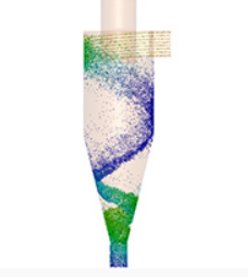Explore the fascinating world of cyclone separators through the lens of Computational Fluid Dynamics (CFD) analysis.
Understanding Cyclone Separators
Cyclone separators are devices used to separate solid particles or droplets from a gas or liquid stream. They operate based on the principle of centrifugal force, where the rotating motion causes heavier particles to move towards the outer wall of the separator, while the lighter particles or cleaner fluid remains in the center.
Understanding the working principles of cyclone separators is crucial for optimizing their performance and designing efficient systems. Factors such as particle size, particle density, and gas velocity play a significant role in the separation process.
Application of CFD in Cyclone Separator Design
Computational Fluid Dynamics (CFD) is a powerful tool used in the design and analysis of cyclone separators. CFD simulations allow engineers to visualize the flow patterns, pressure distributions, and particle trajectories within the separator. By accurately modeling the fluid dynamics, CFD helps to optimize the design parameters such as the cone angle, inlet and outlet dimensions, and vortex finder size.
CFD also enables the evaluation of different operating conditions and their impact on the separation efficiency. It provides valuable insights into the fluid flow behavior, turbulence effects, and particle collection mechanisms, leading to improved cyclone separator designs.
Challenges and Solutions in CFD Analysis of Cyclone Separators
CFD analysis of cyclone separators presents several challenges due to the complex nature of fluid flow and particle behavior. One of the main challenges is accurately capturing the turbulence within the separator, which greatly affects the separation efficiency. High-resolution meshing techniques and advanced turbulence models are employed to overcome this challenge.
Another challenge is accurately modeling the particle-particle and particle-wall interactions. Particle trajectories, collision, and rebound behavior must be accurately simulated to predict the particle collection efficiency. Advanced particle tracking algorithms and validated models are used to address this challenge.
Additionally, the convergence of CFD simulations and the computational resources required for accurate predictions pose challenges. Efficient solvers, parallel computing, and optimization techniques are employed to overcome these challenges.
Ansys Capabilities
Ansys is a leading provider of CFD software widely used in the analysis of cyclone separators. Ansys offers a range of capabilities that enable engineers to accurately simulate and optimize cyclone separator designs such as rich multiphase flow models (DPM, DDPM), Euler-multiphase model, range of turbulence models, and erosion model.
With Ansys, engineers can model complex geometries, accurately simulate fluid flow, turbulence, and particle behavior, and visualize the results in a user-friendly interface. Ansys also provides advanced post-processing tools for in-depth analysis and insights.
Furthermore, Ansys offers optimization tools that help engineers explore different design configurations to maximize the separation efficiency and minimize pressure drop. This allows for the development of highly efficient cyclone separators.
Future Trends in Cyclone Separator CFD Analysis
The field of cyclone separator CFD analysis is continuously evolving, driven by advancements in computing power and simulation techniques. Future trends in this area include the use of machine learning algorithms to enhance the accuracy and efficiency of CFD simulations on the typical applications of particle size distribution and flow field visualization, erosion rate prediction, and separation efficiency.
Additionally, the integration of CFD with other engineering disciplines such as structural analysis and optimization will enable the design of cyclone separators that are not only efficient but also robust and cost-effective.
Furthermore, the development of new materials and manufacturing techniques will open up possibilities for innovative cyclone separator designs with improved performance and reduced environmental impact.
Mar 12, 2024 8:17:50 AM

